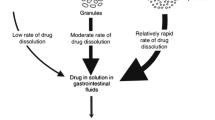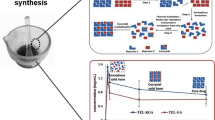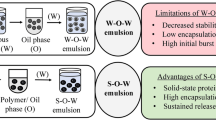Abstract
Orally disintegrating tablet (ODT) is a user friendly and convenient dosage form. The study aimed to investigate the effect of polymers and wheat starch on the tablet properties of lyophilized ODT, with dapoxetine as model drug. Three polymers (hydroxypropylmethyl cellulose, carbopol 934P and Eudragit® EPO) and wheat starch were used as matrix forming materials in preparation of lyophilized ODT. The polymeric dispersion was casted into a mould and kept in a freezer at −20 °C for 4 h before freeze dried for 12 h. It was found that increasing in HPMC and Carbopol 934P concentrations produced tablets with higher hardness and longer disintegration time. In contrast, Eudragit® EPO was unable to form tablet with sufficient hardness at various concentrations. Moreover, HPMC seems to have a stronger effect on tablet hardness compared to Carbopol 934P at the same concentration level. ODT of less friable was obtained. Wheat starch acted as binder which strengthen the hardness of ODTs and prolonged the disintegration time. ODT comprising of HPMC and wheat starch at ratio of 2:1 was found to be optimum based upon the tablet properties. The optimum formulation was palatable and 80 % of the drug was released within 30 min in the dissolution study.



Similar content being viewed by others
References
Adeleye, A.O., M.A. Odeniyi, and K.T. Jaiyeoba. 2011. Evaluation of cissus gum as binder in a paracetamol tablet formulation. Farmacia 59(1): 85–96.
Ahmed, I.S., M.M. Nafadi, and F.A. Fatahalla. 2006. Formulation of fast-dissolving ketoprofen tablet using freeze-drying in blisters technique. Drug Development and Industrial Pharmacy 32: 437–442.
Allen, L.V., B. Wang, and J.D. Davis. 1998. Rapidly dissolving tablet. US patent, 5807567.
Aly El Degwy, M.A.A.E.A., S. Tayel, M.A. El-Nabarawi, and R.T.A. El Rehem. 2012. In vitro and in vivo evaluation of aceclofenac lyophilized orally disintegrating tablets. IJPSR 3(2): 443–459.
Badgujar, B.P., and A.S. Mundada. 2011. The technologies used for developing orally disintegrating tablets: A review. Acta Pharmaceutica 61: 117–139.
Bhasin, R.K., and P.K. Ghosh. 2012. Design and development of ondansetron orally disintegrating tablets and its optimization using design of experiment. IJPSR 3(3): 840–847.
British Pharmacopoeia. 2005. Commission Her Majesty’s Stationary Office: UK.
Brown, D. 2003. Orally disintegrating tablet: Taste over speed. Drug Development and Delivery 3: 6.
Corveleyn, S., and J.P. Remon. 1997. Formulation and production of rapidly disintegrating tablets by lyophilisation using hydrochlorothiazide as a model drug. International Journal of Pharmaceutics 152(2): 215–225.
Dinge, A., and M. Nagarsenker. 2008. Formulation and evaluation of fast dissolving films for delivery of triclosan to the oral cavity. AAPS PharmSciTech 9(2): 349–356.
Dobetti, L. 2001. Fast melting tablets: Development and technologies. Pharm Technology North American 44–50.
Gajbe, J., P. Kenjale, and D.V. Derle. 2013. Effect of ethylcellulose and HPMC K100 M on in vitro release rate of metformin HCl from carbopol 971P matrix tablets. International Journal of Pharmacy and Biomedical Sciences 4(3): 892–896.
Garcia-Gonzalez, N., I.W. Kellaway, H. Blanco Fuente, S. Anguiano Igea, B.O. Delgado Charro, F.J. Espinar, and J. Mendez. 1994. Influence of glycerol concentration and carbopol molecular weight on swelling and drug release characteristics of metoclopramide hydrogels. International Journal of Pharmaceutics 104: 107–113.
Gupta, A., A.K. Mishra, V. Gupta, P. Bansal, R. Singh, and A.K. Singh. 2010. Recent trends of fast dissolving tablet. An overview of formulation technology. International Journal of Pharmaceutical & Biological Archive 1(1): 1–10.
Hiremath, P.S., and R.N. Saha. 2008. Controlled release hydrophilic matrix tablet formulations of isoniazid: Design and in vitro studies. AAPS PharmSciTech. 9(4): 1171–1178.
Kabiri, K., H. Omidian, S.A. Hashemi, and M.J. Zohuriaan-Mehr. 2003. Synthesis of fast swelling superabsorbent hydrogels: Effect of crosslinker type concentration on porosity and absorption rate. European Polymer Journal 39(7): 1341–1348.
Kottke, M.K., H.R. Chueh, and C.T. Rhodes. 1992. Comparison of disintegrant and binder activity of three corn starch products. Drug Development and Industrial Pharmacy 18(20): 2207–2223.
Kizumi, K., Y. Watanabe, and K. Morita. 1997. New method of preparing high porosity rapidly saliva soluble compressed tablets using mannitol with camphor: A sublimating material. International Journal of Pharmaceutics 152: 127–131.
Kundu, S., and P.K. Sahoo. 2008. Recent trends in the developments of orally disintegrating tablet technology. Pharma Times 40(4): 11–15.
Kuno, Y., M. Kojima, and S. Ando. 2005. Evaluation of rapidly disintegrating tablets manufactured by phase transition of sugar alcohols. Journal of Controlled Release 105: 16–22.
Lai, F., E. Pini, F. Corrias, J. Perricci, M. Manconi, A.M. Fadda, and C. Sinico. 2014. Formulation strategy and evaluation of nanocrystal piroxicam orally disintegrating tablets manufacturing by freeze-drying. International Journal of Pharmaceutics 467(1–2): 27–33.
Martindale—The Complete Drug Reference, 33rd Edition 2002 (1499).
Patil, J., C. Kadam, V. Vishwajith, and V. Gopal. 2011. Formulation, design and evaluation of orally disintegrating tablets of loratadine using direct compression process. International Journal of Pharma & Bio Sciences 2(2): 391–400.
Reddy, L.H., B. Ghosh, and Rajneesh. 2002. Fast dissolving drug delivery systems: A review of the literature. Indian Journal of Pharmaceutical Sciences 64(4): 331–336.
Reddy, V.K.S., S. Dondeti, R. Manavalan, and J. Sreekanth. 2010. Comparison of lyophilization and compression technique of Risperidone oral disintegrating tablets. Der Pharma Chemica 2(2): 172–184.
Samran, Karsono, M.T. Simanjuntak, and J. Silalahi. 2014. Optimized formulation of metochlopramide orally disintegrating tablet. Malaysian Journal of Pharmaceutical Sciences (in press).
Sastry, S.V., J.R. Nyshadham, and J.A. Fix. 2000. Recent technological advances in oral drug delivery: A review. Pharmaceutical Science & Technology Today 3: 138–145.
Shoukri, R.A., I.S. Ahmed, and R.N. Shamma. 2009. In vitro and in vivo evaluation of nimesulide lyophilized orally disintegrating tablets. European Journal of Pharmaceutics and Biopharmaceutics 73(1): 162–171.
Tan, Q.Y., L. Zhang, G.D. Liu, D. He, H.F. Yin, H. Wang, J.Y. Wu, H. Liao, and J.Q. Zhang. 2013. Novel taste-masked orally disintegrating tablets for a highly soluble drug with an extremely bitter taste: Design rationale and evaluation. Drug Development and Industrial Pharmacy 39(9): 1364–1371.
Widjaja, B., D. Setyawan, and J. Morchtar. 2013. Development of piroxicam orally disintegrating tablets by freeze drying method. International Journal of Pharmacy & Pharmaceutical Sciences 5(3): 795–798.
Yan, Y.D., S.W. Jong, J.H. Kang, C.S. Yong, and H.G. Choi. 2010. Preparation and evaluation of taste-masked donepezil hydrochloride orally disintegrating tablets. Biological &/and Pharmaceutical Bulletin 33(8): 1364–1370.
Zhou, X., J.Z. Yang, and G.H. Qu. 2007. Study on synthesis and properties of modified starch binder for foundry. Journal of materials processing technology 183(2–3): 407–411.
Acknowledgments
The authors thank University Sains Malaysia for providing the laboratory instruments and facilities for the successful conduct of the research. The authors would like to express deepest gratitude to Kementerian Pengajian Tinggi Malaysia (Higher Education Ministry) for providing the scholarship under MyBrain 15 programme.
Conflict of interest
The authors report no conflict of interest.
Author information
Authors and Affiliations
Corresponding author
Rights and permissions
About this article
Cite this article
Liew, K.B., Peh, K.K. Investigation on the effect of polymer and starch on the tablet properties of lyophilized orally disintegrating tablet. Arch. Pharm. Res. 44, 1–10 (2021). https://doi.org/10.1007/s12272-014-0542-y
Received:
Accepted:
Published:
Issue Date:
DOI: https://doi.org/10.1007/s12272-014-0542-y




